Chinese buddhism and buddhist art


Buddhism’s history in China
After its introduction in China, Buddhism seduced the literate and experienced an extraordinary boom before suffering a fatal blow at the end of the ninth century. Although, some Buddhist orders remained.
In recent history, it almost completely disappeared between the 1950s and 1960s, but since the late 1970s, it has experienced a resurgence like other religions.
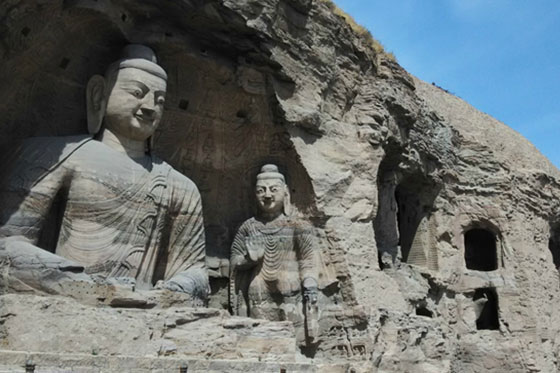
Premices (1st - 3rd century)
This period corresponded with the late Han dynasty.
The opening of the Silk Road between 138 B.C. and 126 B.C. favoured trade with Central Asia and allowed Buddhism’s introduction into China.
It was spread throughout Central Asia by ambassadors, merchants, refugees or missionary monks.
A witnessed testimony mentioned the foundation of the first Buddhist temple in 68. It was ruled by Emperor Mingdi.
Buddhism began to spread north of the Huai River region, and gained followers among the nobility, including Prince Liu Ying, who was the brother of Mingdi, the first prominent Chinese Buddhist.

Buddhism’s roots (4th – 6thcentury)
The Chinese translated and commented the Buddhist texts of the Hinayana, but especially those of the Mahayana, often in collaboration with Indian masters. The oldest translations were confronted with linguistic and conceptual obstacles. In addition, the way of thinking was foreign to them, and this is why the specificity of the Buddha's teaching is only partially restored.
From the 5th century onwards, many monks arrived from Central Asia or India, bringing new texts with them – the translations of which were commissioned by the rulers.
The Indian master Kumarajiva
Disciple de Fotucheng, il dirige de nombreuses traductions et marque une étape importante dans l'établissement de la doctrine mahayana. Ses travaux de traduction et son enseignement forment une génération d'authentiques penseurs. Parmi ses disciples, le plus célèbre Tao-cheng s'installe dans le Sud, et y enseigne une théorie selon laquelle, la présence innée de la « Nature du Bouddha » se trouve dans les êtres vivants, qui peuvent tous devenir des bouddhas. Il oppose le subitisme mahayaniste (grand véhicule) au gradualisme de l’hinayana (petit véhicule), estimant que le premier répond mieux à la mentalité chinoise, encline à saisir le tao, par une intuition directe et synthétique.
Daoan - an important figure (312-385)
His actions were decisive for the rooting of Buddhism in the Northern China. The method he encouraged consisted of translating and interpreting Buddhist texts, with themes and ideas drawn from Taoism, according to an interpretation by an analogy.
His influence was also exerted in Southern China, where his disciple, Huiyuan (344-416) taught devotion to Maitreya, the Buddha of the future. The origin of this cult is the Amitabha cult, which was practiced by the followers of the Jingtu school "Pure Earth", one of the most widespread schools in China.
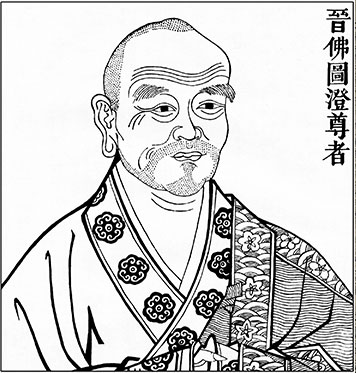
Xuan Zang
His immense knowledge, his true humility, his perilous pilgrimage to India (between 627 and 645), and the translation work he undertook on his return, made him an outstanding figure of this period.
During his stay in India, Xuan Zang studied Mahayanistic philosophy in particular, which he already knew. He also participated in doctrinal debates with the most eminent Indian scholars.
The idealistic system of the philosophy he introduced in China, constituted the foundation of the Faxiang school.
Assimilation
This period corresponded to great political and societal upheavals that favoured Buddhism’s spread. In fact, China was divided into two parts, the North and the South.
In the North, the Mongol princes encouraged a religion that allowed them to find common ground with the people who were under their rule. The Wei kingdom was the first kingdom to make Buddhism a state religion.
Either in the North or the South, the miseries of time and the uncertainties of the future, pushed people in search of a spiritual refuge. There were massive conversions to Buddhism, and the Mingdi Emperor of the Eastern Jin was the first officially converted sovereign in Southern China.
Golden Age (7th century to 845)

After several centuries of assimilation and research, the Chinese people ended up giving Buddhism, which was definitively adopted, a form of its own. Under the Sui (581-618), Buddhism became the state religion of China. The Jingtu Monastery was supported by the government and was the largest Buddhist centre in China.
The Tang Emperors (618-907) adopted Taoism, but Buddhism retained their support, and the theories of the various schools fascinated the cultivated aristocracy. Nevertheless, imperial support implied some control over the functioning of the institutions.
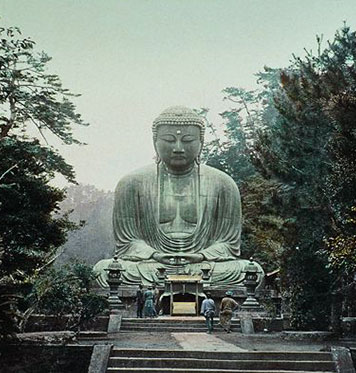
New streams
We witnessed the development of new streams, while Chinese Buddhism was spreading towards Korea and Japan.
As an important corpus had already been translated, the Chinese sought to resolve the contradictions between the different texts of different times and schools, and they strived to build coherent systems which integrated the local philosophical and religious concepts.
The aristocracy's interest in Buddhism was partly linked to the enthusiasm of the cultivated classes for these brilliant and new theories, including Tantric Buddhism.
Special features and rejections
Buddhists did not always abandon their other religious practices. Thus, the mixture of Buddhist and Taoist elements was characteristic of Chinese Buddhism as a whole. It reached the point where it was sometimes impossible to differentiate between the two influences.
Furthermore, at the beginning of this movement, history kept track of its privileged relations with power and its penetration into the upper strata of society.
Buddhism was sometimes violently rejected. Its doctrines and practices faced the virulent criticisms of Confucianism, whose social ideal - which valued filial piety and family order - was particularly opposed to the ascetic and monastic practices of Buddhist monks.
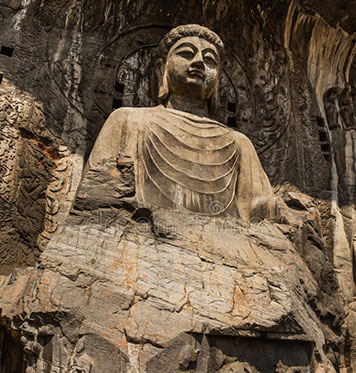
First setbacks
Some monasteries were huge and also served as banks, warehouses or refuge during times of unrest. They benefited directly or indirectly from favourable measures, especially as donations conferred social prestige.
In 420ad, there were 1,768 monasteries and more than 24,000 monks and nuns in the South. 1,367 monasteries were listed in Luoyang in the 8th century.
Their wealth irritated the public, especially as this religion was foreign. Although the measure was temporary, Emperor Wu of the Zhou of the North prohibited it at the same time as Taoism - from 574ad.
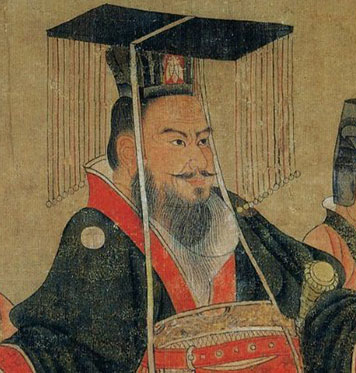
Fatal blow
Oppositions to the new religion were debated. The financial cost of maintaining monasteries and the monks' lives were considered prohibitive.
After the 626 and 714ad persecutions, the persecution of 845ad was a very hard blow. Emperor Wuzong, strongly hostile to foreign religions (Buddhism, Nestorianism, Zoroastrianism), totally forbid them.
4,600 monasteries and 40,000 temples were confiscated and 260,500 monks and nuns returned to civilian life.
The decree was lifted after one year. However, while remaining the most widespread religion of China - by its rites and festivals, it remained intimately linked to the life of the people - Buddhism lost its vitality in the intellectual field.
The decline of Buddhism
After the persecution, only the Chan and Pure Earth streams remained. The other schools did not find their followers again, their attraction had withered away.
The Muslim expansion in the Tarim basin during the 8th century also marked the end of the transmission of knowledge through the Silk Road.
During the following centuries, the Buddhist schools, which survived, gradually absorbed certain notions of Taoism and Confucianism by syncretism.
Under the Song, Neo-Confucianism took off in response to the philosophical domination of the Buddhists. Its thinkers believed that monasticism and karma were notions and practices that were harmful and foreign to Chinese society.
Recent History
Although the eclipse of Buddhism was not complete, it vegetated, as it no longer had the strength to overcome the indifference of rival sects that ceased their hostilities, as they were without object and no longer feared Buddhism’s competition.
It was only in Maoist times - in the 1950s and 1960s - that it almost completely disappeared. Like other religions, it has been experiencing a resurgence since the late 1970s.
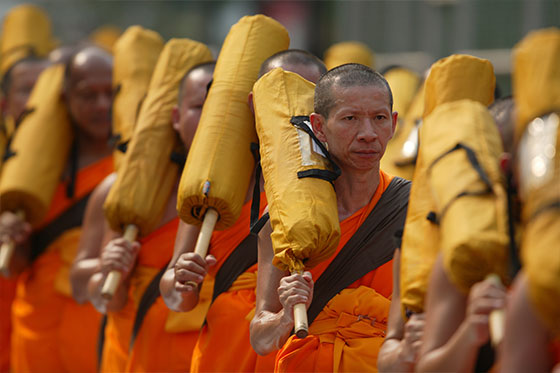
The first schools
They are born between the 3rd and the 4th century, about the first translated sutras.
The Sanlun School or the Three Treaties translated by Kumarajiva. Founded by its disciples, it constituted the Chinese branch of the Madhyamika, which would further develop in Korea and Japan.
The Chengshi School or the Perfection of Truth. This doctrine developed in Japan under the name of Jojitsu school.

The Huayan School. The school was based on the Sutra of flowery ornamentation. One of its major figures, the bodhisattva Manjushri - known in China as Wenshu Pusa, in Japan as Monju and Jampelyang Jampa in Tibet - became the subject of devotion. Mount Wutai in Shanxi province, where he is said to have appeared, is a place of Buddhist pilgrimage.
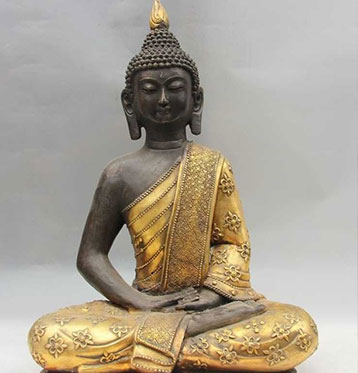
Pure Earth or Jingtu School. Based on the Sutra of Infinite Life, it is remarkable for its practices of recitation and devotion to the Buddha Amitābha (Infinite Life). This current has remained one of the main currents of contemporary Buddhism.
The new streams
Under the Sui (581-618) then the Tang (618-907), new streams developed, while Chinese Buddhism spread to Korea, Japan and Vietnam. If some schools were linked to Indian streams, the most important ones were typically Chinese. Most have their roots in the previous period, but it was during the Tang period that they took on a distinct form.
The Tiantai School or Celestial Terrace. Based on the Lotus Sūtra, it proposes a synthetic theory of Buddhism, which will exert a great influence on Far Eastern Buddhism as a whole. It would inspire the Japanese Tendai stream.
The Chan or the South School. The Chan school appeared from the middle of the 8th century. Its doctrine placed particular emphasis on the direct experience of enlightenment through the most effective and simplest method possible. As for all Chinese Buddhist schools, one can see a Taoist influence in its thought.
In its many forms, Chan became one of the two main categories of Chinese Buddhism, along with the Pure Earth School (Jingtu), in the 9th century.
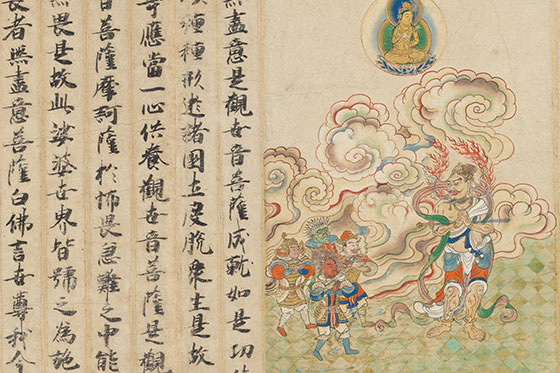
The Tantric or Secret School. This stream, which was introduced by three Indian masters, quickly disappeared but was established in Japan.
It referred to a set of texts, doctrines, rituals and initiation methods, which penetrated most branches of Buddhism in a diffuse way.
Through the practice of rituals and yoga exercises, the follower must transmute their body to integrate it into the forces of the universe, to reach liberation without renouncing the world, and to reach the paradoxical coincidence of divinity and its manifestation. The divinity has two poles: a male pole, which is conscious but inactive, and a female pole, which is active and a creator of energy.
Buddhist Art
Buddhist art constitutes an important part of China's artistic heritage, - and holds an immense artistic treasure, with diverse influences and iconographies that are expressed with magnificence – particularly, in rock art and architecture.
Aesthetic Models
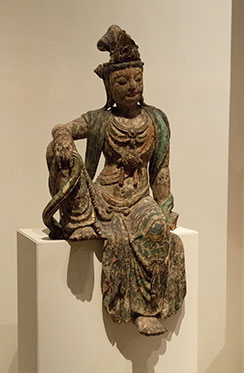
The resumption of Indian models
Chinese artists used Indian iconography and models, inspired by the works of the Gandhara school, which was influenced by Greece itself after the conquests of Alexander the Great in Asia Minor. The panhellenic representations expressed a desire for realism in the modelling of the figures and in the treatment of the monastic garment that covers both shoulders.

The representation modes were asserting themselves
From the 5th> century onwards, artists began to make their mark, thus the treatment of "starched" folds or "swallow wings" saw the light of day. The sculptures lost their roundness and amplitude, and they were lengthened. The shoulders drooped more under the Wei and the bodies disappeared under the garment.
The dynasties of the North, which were in an intellectual quest for Buddhism, developed symbolic and abstract modes of representation. First, their solemn and majestic style lacked realism and distanced itself from the original objective of Buddhism, which was to express the ideal of enlightenment in a realistic and accessible way.

The Gupta Influence
After a transition period under the Sui dynasty, the Buddhist sculpture of the Tang dynasty returned to a more realistic, natural and carnal expression.
The exposure to foreign influences, as well as the resumption of exchanges with Indian culture - thanks to the travels of Chinese monks to India between the 4th and 11th> centuries - made it evolve towards a more classical form, inspired by the Indian Gupta period. The Chang'an capital (now Xi'an) became an important centre of Buddhism, as Buddhism spread to Korea and Japan from there.
Iconography
The Bodhisattva
Introduced into iconography by The Mahayana - a branch of Buddhism intended to be easier for ordinary mortals than Therevada - the Bodhisattva is a character of extreme wisdom and infinite goodness who, when close to reaching Nirvana, blocks the process of accomplishing his own salvation in order to help others attain an awakening comparable to his own.
The Bodhisattva -monk or lay- is worshipped by the devotees who address him with supplications and prayers.
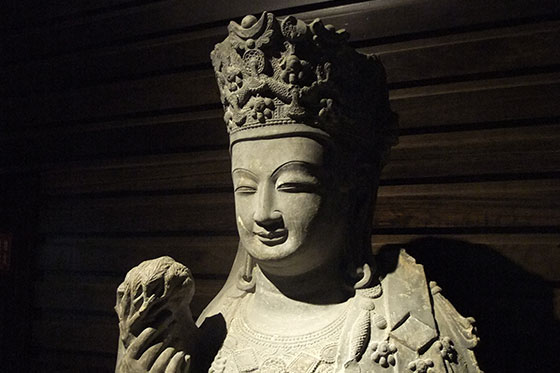
Among the most popular devotional images, those depicting Guanyin in his feminine form, gave artists the opportunity - in sculpture, painting and ceramics - to play with curves and counter-curves by multiplying ribbons, dresses and jewels on a body that was sometimes majestic, or sometimes slender and supple, over the centuries - according to conventions and fashions.
The « mudra »
When it was decided to represent the Buddha at the beginning of our era, symbolic gestures were associated with the main episodes of his life. In this way, despite the apparent uniformity of the representations, the evoked event could be clearly identified.
Nowadays, ritual mudra makes it possible to identify the various Buddhas, bodhisattvas and great characters of the Buddhist pantheon.
The use of "mudra" thus contributes to unifying Buddhist iconography throughout Asia.

The right hand points towards the ground and the fingers touch the ground, while the palm of the left hand is turned towards the sky.
In his last meditation before awakening, Buddha undergoes the attacks of Mara, the personification of evil, who tries to interrupt his meditation by denying the reality of the Buddha’s awakening, arguing that there is no witness. Buddha then touches the earth, to take it to witness.
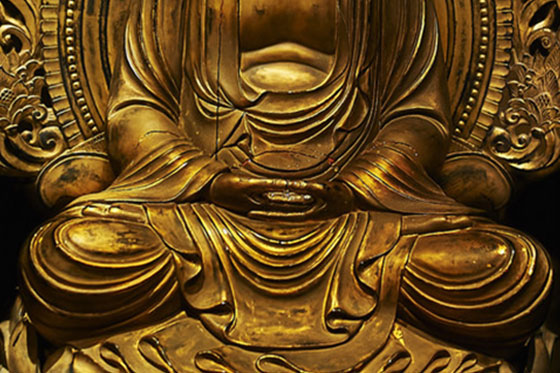
Both hands, one on top of the other, palms up, fingers stretched out on the legs.
This gesture is characteristic of two periods of meditation during Buddha's life - during his period of extreme fasting, and under the bodhi tree before his Awakening.
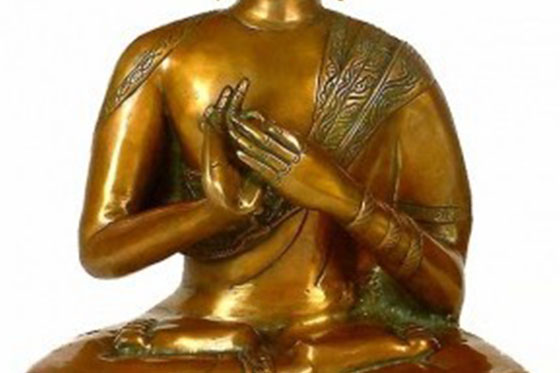
The right hand is vertical, palm facing forward, with the thumb and index finger touching. The left hand is angled and inclined, the palm is turned inward, with the thumb and index finger touching, and the fingers of the left hand touch the right hand.
This gesture of teaching - of setting in motion the wheel of the law - symbolizes the Buddha teaching his disciples.
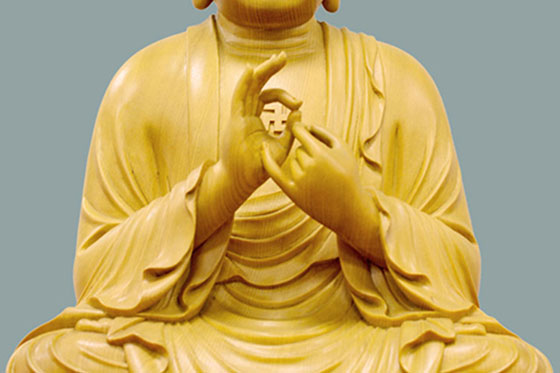
The right hand is raised with the palm facing forward, the fingers are turned outwards and the ends of the thumb and index finger touch. The left hand can also be represented symmetrically.

The right hand is raised with the palm facing outwards and fingers stretched upwards. This representation recalls the scene during which the Buddha is attacked by a furious elephant. Arriving in front of the Master, the animal was subjugated by his serenity – thus, he stopped and kneeled before him, in order to pay homage to him.
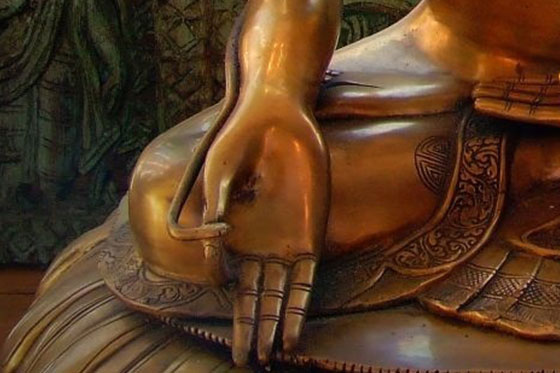
The right hand is open with the palm facing forward and the fingers stretched towards the ground.
This gesture of offering shows that the Buddha keeps nothing locked in his hand and that everything that is there can be spread all over the world.
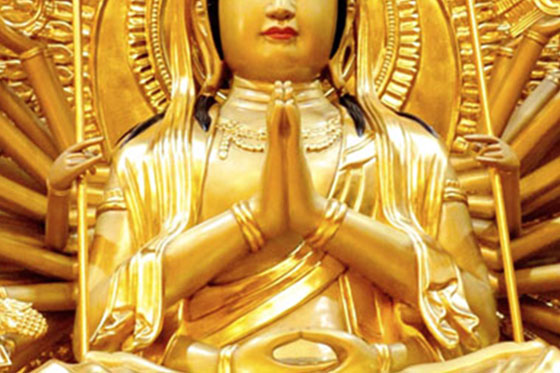
There are several forms of offering gesture - the most common, shows the two hands joined and pointing upwards, with the palms and fingers touching.
This gesture is attributed to the "bodhisattva" who pay homage to the Buddha.
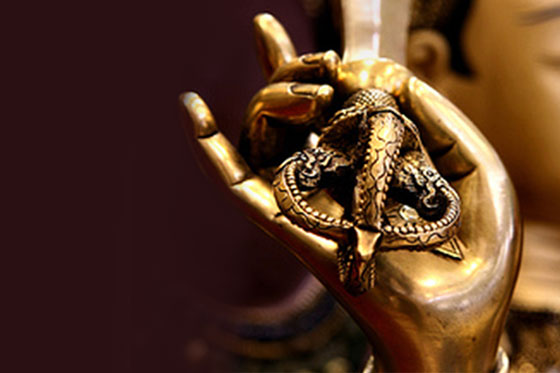
The most frequent gesture shows a closed fist and a horizontal hand with one index finger stretched out. The hand may also be vertical, with the middle finger, ring finger and thumb folded and the other two fingers raised. This gesture symbolizes the warning, which must be understood as an incentive or a reminder to discipline.
Buddhist symbols
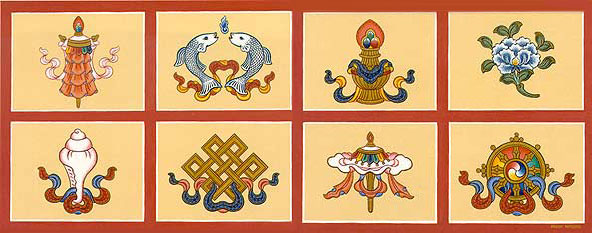
a symbol of royal dignity, represents the protection of suffering.
symbolize the living beings who practice Dharma and are not afraid to drown in the ocean of suffering, since they can freely choose their rebirth.
is a symbol of health, longevity, wealth, prosperity and wisdom.
represents the true nature of beings, which takes place through samsara in beauty and clarity of illumination.
whish is rolled to the right represents the beautiful, deep, melodious sound of the dharma that awakens the disciples from the deep sleep of ignorance.
represents the dependence and interdependence of all phenomena, and also symbolizes compassion and wisdom.
symbolizes the Buddha's victory over the tempting Mara spirit.
symbolizes Buddhist law. It is the most important symbol of Buddhism and it represents the teaching of the Buddha - who was the first to set it in motion. It also represents the endless cycle of birth and rebirth. When the Buddha gave his first sermon, he exposed his doctrine of the four noble truths and the eight steps.
in the Buddhist tradition, often represents esotericism. It can also mean plurality, abundance, prosperity and long life.
Rock Art
The development of Buddhism and Buddhist representations along the Silk Road is explained by the favour enjoyed by this religion under the Tang dynasty - from the 7th> to the 10th> centuries.
In the caves of Dunhuang, Longmen and Yungang, paintings and sculptures carved on cliffsides reflect Indian artistic influences.
Other Buddhist rock sanctuaries of lesser importance exist in Shanxi and Sichuan.
Dunhung Caves (Gansu Province)
From 786 to 848, the Tarim basin is Tibetan territory. Its founder, Songsten Gampo, discovered Indian Buddhism, and Buddhist monks led an austere life in these caves, in pursuit of enlightenment.
The artistic representations - sculptures and paintings that describe the life and work of Siddhartha Gautama, the historical Buddha - offer a material support to collective or private devotion.
The caves were degraded several times - by the Muslims, and then by the white Russians, who used them as refuge at the beginning of the XXth> century.
The cultural revolution spared the site, probably thanks to Zhou Enlai's intervention.
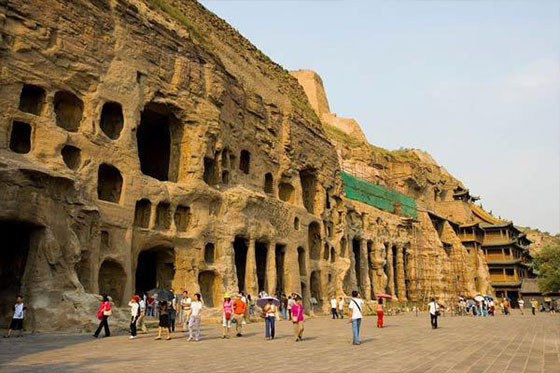
Yungang Sanctuary (Shanxi Province)
The construction of the rock sanctuary of the Wei kingdom dates back to 460. Forty years were needed to carve thirteen colossal statues of Buddha in the sandstone.
The overall design of the work is clearly inspired by Serindian art, but the details are typically Chinese.
From 500, the lines lengthen and the wrinkled clothes become important, the faces become more angular with a pointed nose, the cleft palpebral shrinks and the corners of the lips rise.
Around 540, the shapes are refined, the face is refined and the eyes are almost closed.
The works suddenly stopped in 494 when the capital was transferred to Luoyang.
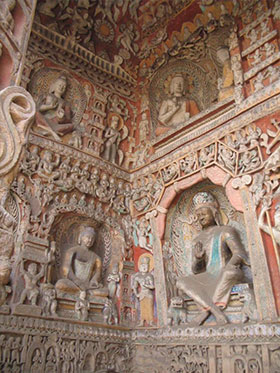
Longmen Caves (Henan Province)
The construction of the caves began in 493.
Longmen's sculptors adopt a style independent of any foreign influence. The site’s limestone lends itself better to a fine cut than in Yungang, and it permits an interesting stylistic evolution, vertical lines, symmetry, treatment of folds, and sharp angles.
The faces shrink, and the bodies lengthen and fade under the heap of the tubular folds of the mantle. The subsequent evolution led to a massive and powerful statuary of art under the Tang, which integrated the naturalism of Gupta art to graphic effects in the purest Chinese tradition.
The site was vandalized at the beginning of the 20th century. Many statues were moved to international museums or mutilated during the Cultural Revolution.
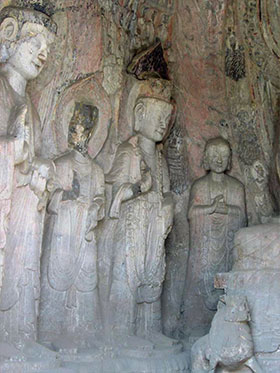
Buddhist architecture

The temple
All Chinese Buddhist temples have similar plans.
All Chinese Buddhist temples have similar plans. A typical example is the Shanhua Temple in Datong, Shanxi Province. It was founded by Emperor Xuanzong (712 - 756) of the Tang dynasty, then rebuilt and restored several times.
The temple is surrounded by an enclosure wall that opens through an entrance pavilion, to the south. It was placed there under the protection of four guards (sometimes two) - itself preceded by a wall, preventing access to evil spirits.
The entrance gives access to the first courtyard where the east pavilion, the west pavilion, and, to the north, the "Three Saints" pavilion are located. Then there is a second courtyard which, to the west, has a small pavilion dedicated to the Puxian Bodhisattva, while the "Mighty Treasure" pavilion is the main building of this monastic complex.

The pagoda
In China, the term pagoda (ta) refers to a tower-shaped building with superimposed roofs, which are found in Buddhist shrines to house relics.
In India, this type of Buddhist building is the Indian stupa, the Tibetan equivalent being the chorten.
Pagodas can be square, hexagonal, octagonal or polygonal. The pagoda does not have a room dedicated to worship, but it often adjoins a monastery.
The 67-meter high pagoda of the Buddha’s Palace monastery (Fogongsi) of Yingxian in Shanxi was built in 1056. It is the only one in the country made entirely out of fire-wood and, as such, is one of the most famous monuments in ancient China.

